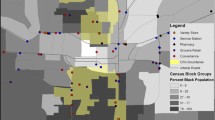Abstract
The population of Greenland is diminishing and environmental and social shifts implicate food availability and the health of reproductive age women. There is little knowledge of the grocery store food environment in Greenland. To address this gap and provide baseline information the present study measured food availability in five grocery stores in northern Greenland. As well, 15 interviews were conducted with reproductive age women, three grocery store managers were interviewed and one interview was conducted with a food distribution manager. Results show few fresh fruits and vegetables are available in grocery stores and in some stores no fresh foods are available. In Kullorsuaq, the primary location for this study, the Nutrition Environment Measures Survey in Stores score in spring 2016 was (3/30) and the Freedman Grocery Store Survey Score was (11/49). Interview results highlight a need to increase communication within the food system and to tailor food distribution policies to the Arctic context with longer term planning protocols for food distribution. These findings can be used to inform future food store environment research in Greenland and for informing policies that improve healthful food availability in grocery stores in northern Greenland.


Similar content being viewed by others
References
Popkin, B. M. (2006). Global nutrition dynamics: the world is shifting rapidly toward a diet linked with non-communicable diseases. American Journal of Clinical Nutrition, 84(2), 289–298.
Sallis, J. F., & Glanz, K. (2009). Physical activity and food environments: Solutions to the obesity epidemic. The Milbank Quarterly, 87(1), 123–154.
Jeppesen, C., Bjerregaard, P., & Jørgensen, M. (2014). Dietary patterns in Greenland and their relationship with type 2 diabetes mellitus and glucose intolerance. Public Health Nutrition, 17(2), 462–470. doi:10.1017/S136898001300013X.
Deutch, B., Dyerberg, J., Pedersen, H. S., Asmund, G., Møller, P., & Hansen, J. C. (2006). Dietary composition and contaminants in north Greenland, in the 1970s and 2004. Science of the Total Environment, 370(2), 372–381.
Knudsen, A.-K. S., Long, M., Pedersen, H. S., & Bonefeld-Jørgensen, E. C. (2015). Lifestyle, reproductive factors and food intake in Greenlandic pregnant women: The ACCEPT–sub-study. International Journal of Circumpolar Health, 74(1), 29469. doi:10.3402/ijch.v74.29469.
Bjerregaard, P., & Jeppeson, C. (2012). Consumption of traditional food and adherence to nutrition recommendations in Greenland. Scandinavian Journal of Public Health, 40(5), 475–481.
Long, M., Knudsen, A. K. S., Pedersen, H. S., & Bonefeld-Jørgensen, E. C. (2015). Food intake and serum persistent organic pollutants in the Greenlandic pregnant women: the ACCEPT sub-study. Science of the Total Environment, 529, 198–212.
Sowa F. (2015). Kalaalimernit: The Greenlandic taste for local foods in a globalized world. Polar Record, 51(258), 290–300 doi:10.1017/S0032247414000187.
The World Facebook. (2016). Greenland. https://www.cia.gov/library/publications/the-world-factbook/geos/print_gl.html.
Johnston, W. R. (2017). http://www.johnstonsarchive.net/policy/abortion/index.html.
Nazni, P. (2014). Association of western diet & lifestyle with decreased fertility. The Indian Journal of Medical Research, 140(Suppl 1), S78–S81.
World Health Organization and Food and Agriculture Organization of the United Nations (WHO/FAO). (2004). Vitamin and mineral requirements in human nutrition, 2nd edn. Report of a Joint FAO/WHO Expert Consultation. Geneva.
Glanz, K., Sallis, J. F., Saelens, B. E., & Frank, L. D. (2007). Nutrition Environment Measures Survey in stores (NEMS-S): Development and evaluation. American Journal of Preventative Medicine, 32(4), 282–289.
Freedman, D. A. (2009). Local food environments: They’re all stocked differently. American Journal of Community Psychology, 44(3–4), 382–393.
Hammersley, M., & Atkinson, P. (1995). Ethnography principles in practice. London: Routledge.
Sallis J., Owen N., & Fisher E. (2008). Ecological Models of Health Behavior. In K. Glanz, B. Rimer, & K. Viswanath (Eds.), Health Education and Health Behavior (4th edn.) San Francisco. Jossey-Bass.
Creswell, J. (2014). Research design: Qualitative, quantitative and mixed methods approaches (4th edn.). Los Angeles: Sage Publications.
Statistics Greenland. (2016). Population. http://bank.stat.gl/pxweb/.
Greenland Government. (2015). http://www.greenland-guide.gl/.
Statistics Greenland. (2016). Statistical Yearbook 2016. http://www.stat.gl/.
World Health Organization. (2015). Women’s health fact sheet. Retrieved from http://www.who.int/mediacentre/factsheets/fs334/en/.
Byker-Shanks C., Ahmed S. (2016). Understanding food environments. Unpublished manuscript.
KNI. (2017). Pilersuisoq. Greenland. http://www.kni.gl/en/kni/vores-samfundsansvar/.
Huet, C., Rosol, R., & Egeland, G. M. (2012). The prevalence of food insecurity is high and the diet quality poor in Inuit communities. The Journal of Nutrition, 142(3), 541–547.
Mead, E., Gittelsohn, J., Kratzmann, M., Roache, C., & Sharma, S. (2010). Impact of the changing food environment on the dietary practices of an Inuit population in Arctic Canada. Journal of Human Nutrition and Dietetics, 23(Suppl. 1), 18–26.
Sharma S, Gittelsohn J, Rosol R, Beck L. (2010). Addressing the public health burden caused by the nutrition transition through the Healthy Foods North nutrition and lifestyle intervention programme. Journal of Human Nutrition and Dietetics, 23, 120–128.
Kolahdooz, F., Pakseresht, M., Mead, E., Beck, L., Corriveau, A., & Sharma, S. (2014). Impact of the Healthy Foods North nutrition intervention program on Inuit and Inuvialuit food consumption and preparation methods in Canadian Arctic communities. Nutrition Journal, 13, 68. http://doi.org/10.1186/1475-2891-13-68.
Skaarup Knudsen, A., Long, M., Pedersen, H., & Bonefeld-Jørgensen, E. (2015). Lifestyle, reproductive factors and food intake in Greenlandic pregnant women: The ACCEPT—sub-study. International Journal of Circumpolar Health, 74(1),29469. doi:10.3402/ijch.v74.29469.
Funding
Population dynamics in Greenland: a multi-component mixed methods study of the dynamics of pregnancy in Greenland (National Science Foundation, Award 1319651, PI- Dr. Elizabeth Rink).
Author information
Authors and Affiliations
Corresponding author
Ethics declarations
Conflict of interest
The authors declare that they have no conflict of interest.
Rights and permissions
About this article
Cite this article
Watson, Z.A., Shanks, C.B., Miles, M.P. et al. The Grocery Store Food Environment in Northern Greenland and Its Implications for the Health of Reproductive Age Women. J Community Health 43, 175–185 (2018). https://doi.org/10.1007/s10900-017-0400-1
Published:
Issue Date:
DOI: https://doi.org/10.1007/s10900-017-0400-1




